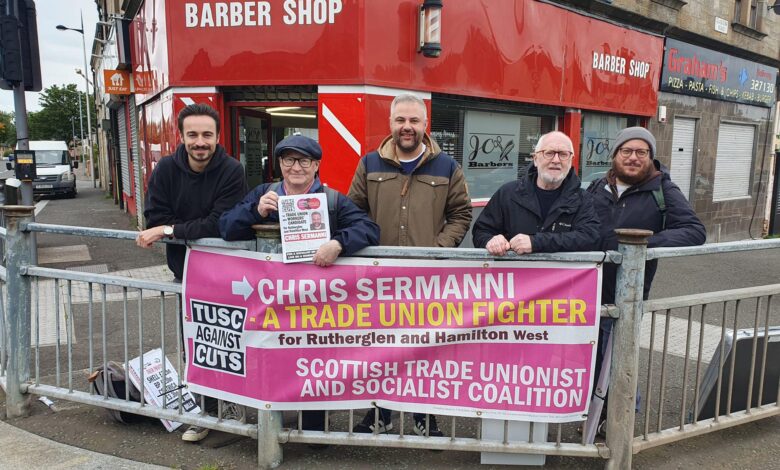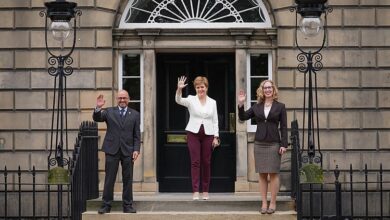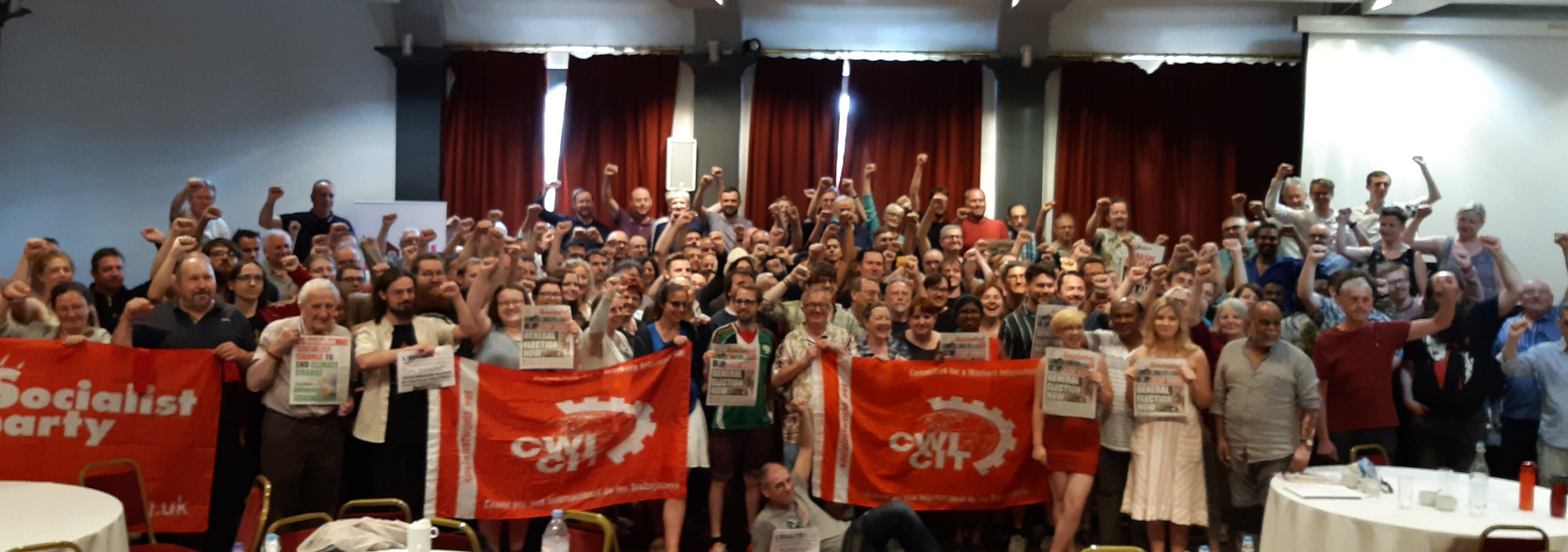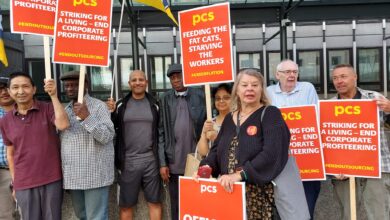Rutherglen and Hamilton West: The reality behind Labour’s by-election euphoria
Build a new party for the working class

Matt Dobson and Philip Stott
The Rutherglen and Hamilton West by-election was a massive vote of no confidence in the main pro-capitalist parties. Despite intense attention from the media and the political establishment, and major resources expended by Labour and the SNP in particular, there was evident and palpable anger in this predominantly working-class constituency. Anger over the cost of living crisis but, above all, towards the politicians responsible for the economic disaster, especially the Tories and the SNP.
Above all else this mood was reflected in a collapse in the turnout. From 66% in the 2019 general election to just 37%. That more than 6 out of 10 voters did not take part is a damning indictment of what was on offer. As the Guardian correspondent commented, there was “antagonism towards mainstream politics”.
Scottish Labour’s neo-Blairite Micheal Shanks won with a 20% swing from the SNP to Labour. Yet Labour’s number of votes were lower when compared to both the 2019 and 2017 general elections when Jeremy Corbyn was Labour leader. Shanks resigned his party membership in protest at Corbyn’s leadership and only re-joined when Starmer took over.
The result was a brutal electoral defeat for the SNP who saw their share of the vote fall from 44.2% to 27.6%. The by-election was the first one ever to take place following a re-call petition to remove a sitting MP – in this case the SNP’s Margaret Ferrier.
This will have been a factor in the falling away of SNP support. Far bigger though was the SNP’s alienation from large sections of the working class in Scotland, which has accelerated since Nicola Sturgeon’s resignation as party leader earlier this year.
It’s a product of the widespread disappointment in working-class communities who put their faith in the SNP after the 2014 indyref in particular but who have delivered little other than cuts to public services and holding down of workers’ pay.
Keir Starmer described the result as “seismic”, putting Labour on course for a sizeable majority or even a “landslide” at the forthcoming UK general election. But there was little enthusiasm for Labour by workers for Labour’s pro-big business policies other than a vehicle to hit back at the SNP and a desire to get the Tories out. Some SNP voters backed Labour, but thousands of pro-independence supporters simply refused to vote.
No party other than the SNP and Labour held their deposit. Both the Tories and the Lib Dems saw their previous voter base vanish to Labour. In fact 86% of the electorate that voted backed either Labour or the SNP in a highly polarised election between these two camps, underpinned by the divisions over Scottish independence.
However, it was an election that did not see independence feature heavily. It was the cost of living and the economic problems facing the working-class majority in the constituency that dominated, with nothing other than lip-service ‘solutions’ being paid by the main candidates.
The anger towards the main parties was palpable. The Scottish Trade Unionist and Socialist Coalition (TUSC), which includes Socialist Party Scotland members, heard this “a plague on all their houses” mood repeatedly. There is a colossal political vacuum in working class areas that only a mass working class party based on the organised power of the trade unions could attempt to fill.
During the election campaign, the UNISON schools’ strikes took place, which saw tens of thousands of low paid workers taking action for three days. It was a glimpse of the enthusiasm when a credible option to fight back is given to working class people. This was of course the main idea Scottish TUSC fought for and strove to give a voice to in this election.
Labour’s victory will lead, they hope, in a general election in 2024 to them regaining seats from the SNP in working-class areas in Scotland. Labour currently only hold two of the 59 Westminster seats but hope to win back at least two dozen seats from the capitalist nationalist party.
For the Humza Yousaf SNP leadership, this result is the worst case scenario come true. They are being undermined by their record in government since 2007 of passing on austerity and attacks on the working class.
They critically have no strategy to build a campaign to gain concessions from the British ruling class, especially a future Starmer government, on the democratic right to self determination and a second independence referendum. Yousaf’s leadership could be challenged before the next general election in a desperate attempt to hold on in Scotland.
Scottish TUSC campaign
In a polarised election amid a collapsing turnout, Chris Sermanni and Scottish TUSC standing for the first time in the seat polled 178 votes (0.6%). This vote, while modest, does not fully reflect the very positive support we received on stalls and on the doors and for our leaflets which highlighted the idea of a local trade union fighter standing for socialist policies to fight the cost-of-living crisis.
Many voters said they fully agreed with our calls for nationalisation of the energy companies, for a £15 an hour minimum wage without exemptions, no cuts budgets and for a MP who would live on a skilled workers’ wage.
Despite our limited resources and lack of media attention, there was also significant active support for Chris from shop stewards and trade union activists out campaigning in the seat, including from the CWU, Unison, EIS, Unite and the GMB.
Understandably, the pressure to vote Labour or SNP was powerful as “you cannot win at the moment”. Chris became seen as “the trade union guy involved with the strikes”. The idea we fought for, very prominently, of a new workers’ party based on the trade unions also gained support and marked us out from the other socialist candidate in the race.
The Scottish Socialist Party (SSP) polled 271 votes, amounting to 0.9% of the vote. The SSP previously had a national profile with six MSPs at Holyrood between 1999 and 2007, polling 1164 votes, 2.7%, in Rutherglen and Hamilton West in the 2005 general election.
As it was the fact that standing for the first time Scottish TUSC was able to win 40% of the modest socialist vote was important. We hope going forward its possible to avoid clashes like this in the future. Although its clear that the political differences in approach between Scottish TUSC and the SSP, that we explain below, mean that can be a challenging issue.
The Rutherglen and Hamilton by-election underlines the burning need for a workers’ and socialist list of candidates to give a voice to the strike wave and take on the SNP, Starmer’s Labour and the Tories at the next general election.
Scottish TUSC and Socialist Party Scotland will work with all those who want to see a new mass party for the working class to assist the fight for a socialist future.
A way forward for socialists in elections
Scottish TUSC had selected Chris Sermanni – a Glasgow UNISON convener from one of the most combative and left wing branches of the union in Scotland – as our candidate on the 25th May. Around six weeks later the Scottish Socialist Party (SSP) announced they intended to stand. This was despite Scottish TUSC offering discussions on the issue even before we announced Chris, who lives in the constituency, as the candidate.
Our appeals for meeting to discuss the possibility of a single socialist candidate were ignored until eventually, in August, a discussion did take place between Scottish TUSC and the SSP. Unfortunately, agreement could not be reached for a single socialist candidate. Not least because of the significant differences in political approach on the need to build a new workers’ party based on the trade unions and on other political issues. These differences became more pronounced during the election campaign itself.
The SSP, which many members of Socialist Party Scotland helped found in 1998, had an important and sizeable base of support among the working class. From 1999 until 2007, the party, at its height, had six MSPs elected to Holyrood. They also won the affiliation of the RMT trade union at a national level. The serious political mistakes of the SSP leadership on a range of issues contributed significantly to its electoral demise. It has failed to regain anything like that level of support since.
In the run-up to the 2014 indyref, the SSP formed a campaign bloc with the SNP and the Scottish Greens called Yes Scotland to make the case for Scottish independence. Socialist Party Scotland did not seek to take part in Yes Scotland as it was dominated by the pro-capitalist ideas of the SNP. Instead we helped establish the socialist campaign for independence.
Immediately after the 2014 referendum the SSP even went as far as to propose an electoral agreement with the SNP and Greens for a single pro-independence candidate in each constituency, despite the SNP’s anti-working class policies and practices.
The SSP has, based on this election, continued to adopt a position of being far too soft on the SNP.
It’s clear that the SSP hoped to attract a sizeable pro-independence layer disenchanted with the SNP, plus some who were attracted to Corbynism in the past. In their election material there were some significant political concessions they made to the SNP in an attempt to make a breakthrough, which ultimately did not work.
The SSP’s main A5 two-sided leaflet which they used the most in their campaign did not mention the pro-independence SNP/ Greens record who make up the Scottish government. It focused criticism instead on Scottish Labour who they termed the “continuity Tories”.
In contrast, both the Scottish TUSC leaflets made it crystal clear that Labour and the SNP do not fight for us! On the eve of polling, a longer A5 four sided leaflet was posted by SSP members online that did mention “Labour and the SNP” being responsible for council cuts and PFI but the main focus was still on Scottish Labour.
In none of the SSP material we have seen was there any criticism of the SNP’s strategy around fighting for self-determination. Scottish TUSC said clearly “unlike the SNP and the Greens we fight for socialism. To win self-determination means convincing a big majority our lives would be better. We have no illusions that a bosses independent Scotland, where big business controls the economy would deliver for the working class. That’s the SNP vision. We want to see an Independent Socialist Scotland”
There was also a major difference on the question of raising the idea of a new workers’ party based on the trade unions. We said we need a party to fight for the working class and called on the trade unions to build such a party. The SSP claim already to be that party, stating in their longer leaflet: “Vote SSP – the workers party”. We think this is a serious mistake. Far better to argue that a new mass workers’ party needs to be built, made of a socialists, trade unions and the wider working class.
The SSP also ridiculously on social media made references to having the only socialist candidate. “Bill Bonnar and the SSP are the only opposition to the failed capitalist system standing in Rutherglen and Hamilton West”, was one such example.
Scottish TUSC’s offer to the SSP to participate in the coalition still stands, including taking part in the steering committee with full rights. We hope to have more discussion regarding forthcoming elections in the future.



